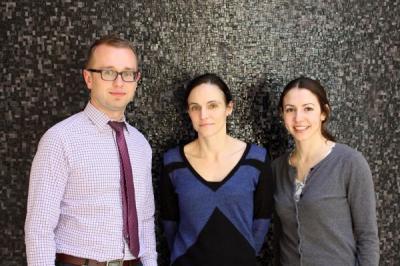Researchers from the University of Toronto's Department of Laboratory Medicine and Pathobiology (LMP) have defined potential treatment targets for a previously incurable form of pediatric brain cancer called Diffuse Intrinsic Pontine Glioma (DIPG).
In groundbreaking research published in Nature Genetics, Dr. Cynthia Hawkins, a professor at LMP and Neuropathologist and Scientist at The Hospital for Sick Children, along with PhD candidates Pawel Buczkowicz and Patricia Rakopoulos, identified three subgroups of DIPG, each having distinct molecular features.
"In the past, DIPGs were considered one disease and were assumed to be similar to adult brain tumours. For this reason, the treatments that were given to adults were also given to children—but these treatments were ineffective," said lead author Buczkowicz. By studying the differences between these tumours, the team can now investigate potential treatments and provide hope for future patients.

This shows (L to R) Pawel Buczkowicz, Cynthia Hawkins and Patricia Rakopoulos.
(Photo Credit: LMP, U of T)
Previously, doctors used MRI or CT scans to diagnose and study DIPGs, but the information obtained was limited. In addition, it was difficult to study these tumours because they were rarely biopsied and tissue samples were rare. Hawkins began an autopsy-based study to gain a comprehensive perspective of the disease, an approach that has paid dividends.
DIPGs are most commonly diagnosed in children between the ages of 5 and 9 and account for 10 to 15 percent of all pediatric central nervous system tumours. For over 25 years, children diagnosed with this incurable brainstem tumour have had few treatment options since the cancer cells are intimately intermingled with normal brain cells. These tumours are inoperable, current chemotherapy is ineffective and focal radiation only provides temporary treatment.
As Hawkins pointed out, "We're hoping that by having a better genetic characterization of these cancers we can try to better target these tumours and provide a personalized approach to treatment. The ideal is always that we're going to find something that will zap all of the tumour cells and we're going to find a cure. But probably a more realistic interim goal is that we can at least slow it down."
Phase I clinical trials for DIPG could potentially begin within a year.
Source: University of Toronto